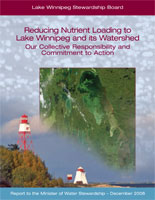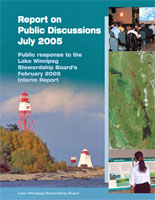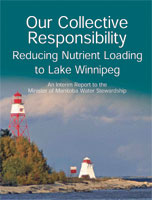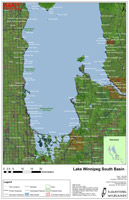|
 Manitoba's Clean Environment Commission (CEC) held public hearings in communities and downtown Winnipeg, starting December 2014, to assess the effects of regulation of Lake Winnipeg as a reservoir to serve Manitoba Hydro's system across northern Manitoba. The question put to them was whether to issue a final licence for regulation of the lake, on the same terms as the forty year old interim licence.
Manitoba's Clean Environment Commission (CEC) held public hearings in communities and downtown Winnipeg, starting December 2014, to assess the effects of regulation of Lake Winnipeg as a reservoir to serve Manitoba Hydro's system across northern Manitoba. The question put to them was whether to issue a final licence for regulation of the lake, on the same terms as the forty year old interim licence.
The hearings continued until April 2015, with a delay till early May for one outstanding community hearing. Many affected held community hearings, and participated in the Winnipeg hearings.
Manitoba's Environment Act is clear about the timeline before the Commission report and recommendations are supposed to go to Cabinet. CEC reports are then supposed to be made public soon after cabinet receives the report. Recent examples of this sequence are the Bipole III, Keeyask Generation, Winnipeg Floodway Expansion reports to cabinet. Each was made public about one week after being provided to cabinet.
As of October 9, 2015 no one knows the status of the CEC report on Lake Winnipeg Regulation. Exhaustive hearings were held, after a forty year period with no public review and no environmental assessment of regulation of Lake Winnipeg, and Manitobans still do not know the results or recommendations.
First Nations Section 35 community consultations about the potential effects of regulation of Lake Winnipeg on aboriginal land and water uses, and aboriginal rights are also moving slowly. This is despite first notification by the Manitoba crown of the intended consultations being sent to affected communities in January 2014.
The results of both Aboriginal Section 35 consultations and the CEC hearings must be in the Minister's hands before a decision about the requested final licence for regulation of Lake Winnipeg can be made. The CEC report is now well past the prescribed timeline in the Environment Act.
Manitoba Wildlands, a participant in the hearings, is concerned the Manitoba government may not realize how important this CEC set of recommendations is for the future of the Lake, and the communities around the lake. Many Manitobans are waiting for this CEC report. We expect it to be released very soon.
View Clean Environment Commission Lake Winnipeg Regulation hearings
View Manitoba Hydro Lake Winnipeg Regulation page
View Manitoba Conservation and Water Stewardship Lake Winnipeg regulation page
 On June 3, 2015 Premier Greg Selinger told the Manitoba Legislature, during a question period in Estimates for Manitoba Conservation and Water Stewardship, that Section 35 Aboriginal Consultations with communities affected by Lake Winnipeg Regulation would go forward. On June 3, 2015 Premier Greg Selinger told the Manitoba Legislature, during a question period in Estimates for Manitoba Conservation and Water Stewardship, that Section 35 Aboriginal Consultations with communities affected by Lake Winnipeg Regulation would go forward.
Despite the Clean Environment Commission hearings about Lake Winnipeg Regulation ending in April 2015 with their report due August 2015, Section 35 consultations had not started yet. The government sent a package to about 40 communities deemed to be affected by regulation of Lake Winnipeg water levels in early 2014.
Premier Selinger made the commitment for Aboriginal Consultations in Manitoba when he held a two day event with Manitoba First Nations and his ministers, in Brokenhead June 2010. At the time a five year fund was established. Projects such as Bipole III, Keeyask Generation Station, and various mining dispositions, road building, and other projects have been subject to community consultation.
The standards Manitoba is applying to these community consultations are from 2009. No First Nation or Metis review was involved before the standards were put in place.
The same day an Assistant Deputy Minister in Manitoba Conservation and Water Stewardship was attending a Lake Winnipeg gathering in Brokenhead. To see the questions and his answers about Lake Winnipeg consultations see link below.
View June 3, 2015 Manitoba Wildlands Comments from Brokenhead Ojibway Nation meeting
On Thursday April 9, 2015 Manitoba Wildlands brought its participant presentations to the CEC hearings. We are providing description and links to the presentations below.
Climate Change Expert
Paul Beckwith, phd candidate at University of Ottawa, who frequently posts climate change content on U Tube and social media, provided a technical report to the CEC and a presentation via Skype to the Lake Winnipeg Regulation hearings for Manitoba Wildlands. His speciality is accelerated climate change especially in northern regions.
Mr. Beckwith aimed to caution Manitoba Hydro about relying on too many past years in running their models, thereby weighting climate change analysis on past decades and missing the rapid changes taking place. He also cautioned Manitoba Hydro about continuing to assume that climate change is a linear set of measurable effects given the climate system is rapidly becoming nonlinear.
Manitoba Hydro's analysis for these hearings is that climate change will not affect the lake until around 2050.
Links for his report and presentation on the CEC website are:
CEC Transcript is at : http://www.cecmanitoba.ca/resource/hearings/33/lwrapr0915.pdf
View Manitoba Wildlands Lake Winnipeg Climate Change Report by Paul Beckwith
View Climate System: Lake Winnipeg Watershed - Hearings Presentation by Paul Beckwith
Public Policy about Lake Winnipeg
Manitoba Wildlands researchers built a workbook with sheets for specific kinds of public policy products about Lake Winnipeg.
We were only able to conduct a desk search, relying on our own holdings and online materials. Fifty pages later it was evident that we have a great deal of public policy and law that affects Lake Winnipeg. Despite this there appears to be no actual Lake Winnipeg governance system, no management, monitoring, or protection system. Most public policy and laws are actually single issue, single topic, single issue, single action. Almost all Lake Winnipeg public policy ignores that fact that that lake is the main reservoir for the entire Hydro system in the province.
View April 9, 2015 Manitoba Clean Environment Commission transcript
Closing Statements from Manitoba Wildlands
View Manitoba Wildlands closing statements transcript, April 16 at 9:30 AM
View Manitoba Wildlands formal written closing statements
View Manitoba Wildlands Public Policy Introduction and Chart
View Manitoba Wildlands Lake Winnipeg Public Policy Report
View Manitoba Wildlands Lake Winnipeg Public Policy presentation
 This week during the Lake Winnipeg Regulation hearings in Winnipeg two speakers, with legal counsel for the Interlake Reserves Tribal Council, made presentations.
This week during the Lake Winnipeg Regulation hearings in Winnipeg two speakers, with legal counsel for the Interlake Reserves Tribal Council, made presentations.
The speakers, Councillor Derek Gould, from Pinaymoorang First Nation and Elder Henry Traverse of Kinonjeoshtegon First Nation, shared their knowledge about changes in Lake Winnipeg since regulation. Both commercial fishers, they told the commission about a range of changes in the lake especially since the 1980's. They identified water level fluctuations that are not natural, current changes, spawning grounds changing, and increased safety risks in both the summer waters and on the ice for winter fishing.
After their presentation Manitoba Hydro legal counsel asked both speakers questions about traditional knowledge (termed ATK by the utility).
In particular legal counsel expressed concern about ATK given that Elders are being lost, language is being lost, and showed an assumed risk of losing traditional knowledge all together. Manitoba Hydro also stated that each community has different traditional knowledge - ignoring the extensive contribution by First Nations in two previous sets of regulatory hearings to identify what is unique to a community, and what is common in traditional knowledge, natural laws and belief systems. These former hearing contributions included extensive information about the Ojibway belief system, and where it coincides with Cree beliefs and traditional knowledge. Cree panels, especially in the Keeyaks Generation hearings in 2013, identified common Cree traditional knowledge, and natural laws, while acknowledging where these connect with Ojibway beliefs and traditional knowledge.
The speakers were clear that the English language is also used to transfer traditional knowledge. The stories or teachings also have an application to a range of practices on the land and waters, which the IRTC speakers pointed out. They assisted legal counsel by pointing out that ATK is not just oral history, rather it is knowledge upon which practices today are based.
Manitoba Hydro has a proposal to fund gathering of ATK around Lake Winnipeg, through a group of two or three other external organizations. It was not clear thought whether the utility understands where traditional knowledge comes from, who carries traditional knowledge, how the teachings apply to today's world, and how 'ATK' is used by First Nations.
IISD Presents Three Primary Issues for Lake
Dr. Hank Venema and his team from the International Institute for Sustainable Development also presented to the CEC hearings this past week. Their report makes several recommendations, and places climate change impacts on Lake Winnipeg central to planning for the future of the Lake.
IISD identified ways to reduce the dramatic increase of inflows for Lake Winnipeg, while also discussing a water market to valuate ecosystem services in the basin. IISD also provided a set of indices and charts to show the relationship Lake Winnipeg has to its basin, volume, and geography.
Manitoba Hydro counsel asked if their recommendations were viable if only Manitoba acted, and how they saw the five jurisdictions in the basin cooperating.
Therefore, our overarching recommendation is that there is need for a framework for basin-wide management, and that ecosystem services should be an integral part of its design. The Lake Friendly Accord and Lake Friendly Stewards Alliance may already be building this groundwork. We further recommend that an entity be created to help guide basin-wide management, or that an already existing entity be provided support and resources for this mandate.
IISD provided additional recommendations:
- Consider the land as infrastructure.
- Invest in upstream management, including storage to influence Lake Winnipeg levels and power generation.
- Use financial mechanisms, such as water markets, to generate ecosystem services.
- Manage upstream for nutrient capture.
- Manage upstream for climate change adaptation and natural hazard buffering.
Reports, presentation materials and transcripts for the week are available on the CEC website. No hearings will be held the week of March 30, 2015.
 CEC experts presented evidence this week (March 16 – 19) at the Manitoba Clean Environment Commission (CEC) hearings to review the 40 year interim licence for regulation of water levels in Lake Winnipeg (LWR). The hearings are to investigate the request for a final licence for regulation of Lake Winnipeg by Manitoba Hydro.
CEC experts presented evidence this week (March 16 – 19) at the Manitoba Clean Environment Commission (CEC) hearings to review the 40 year interim licence for regulation of water levels in Lake Winnipeg (LWR). The hearings are to investigate the request for a final licence for regulation of Lake Winnipeg by Manitoba Hydro.
The Minister for the Water Power Act, in Manitoba's cabinet, will determine whether to issue the final licence. The recommendations of the CEC and the results of First Nation consultations are the primary sets of information the Minister uses for the decision. The final licence would be backdated to 1976, which means that a renewal of that licence would need to be in place for 2026.
Participants and CEC experts are making presentations, asking questions, and identifying gaps in data, for both scientific and technical information.
Coastal Wetlands
Dr. Gordon Goldsborough of the University of Manitoba reviewed the status of Netley and Libau marshes at the mouth of the Red River, where it flows into the south basin of Lake Winnipeg. His analysis applies to the many coastal wetlands and marshes around the lake. Netley and Libau marshes are dramatically different than 100 years ago, and have experienced more significant changes since the 1970s. Dr. Goldsborough outlined what needs to happen in lake water levels for the coastal wetlands and marshes to regain their ecosystem functions and services.
His analysis focuses on the effects of unnatural and unexpected water flows, where natural low levels needed by marshes do not occur. Water from the Red River Floodway around Winnipeg meets regulated water levels for Lake Winnipeg in the Netley Libau marshes. The Red River Floodway goes into operation when the St. James Avenue regulation as to water elevation inside Winnipeg is triggered. A full history of those marshes, including dredging, channeling etc, are provided.
Operating Rules
Dr. George McMahon, a retired US Corp of Engineers reservoir expert, attended the hearings for a week, including to hear the Manitoba Hydro panel presentation. Dr. McMahon reviewed the hydrological and operations models, and planning standards for regulation of Lake Winnipeg water levels. His observations included the need for the whole hydro system to be operated, managed, and planned together. To this goal he recommends public operating rules for each generation station and reservoir. These operating rules would become a suite of operating rules by which the hydro system could be audited, reviewed, adjusted, or changed.
His advice means the scope of the LWR review underway is constrained because the Churchill River Diversion, South Indian Lake, and Wuskwatim would need to be included. Currently they are not included in the LWR review. To date there has been no public process to review the request for a final licence for the Churchill River Diversion.
Dr. McMahon was clear that once operating rules are in place they are also to be used for planning. His primary advice appears to be that Manitoba Hydro needs to find the tools to plan operation of the hydro system in the province. He indicated that current modeling and analyses are narrow, and a constraint on long term planning.
Dr. McMahon also had advice for the utility about public engagement, and community meetings etc. He was clear that transparent engagement with all stakeholders which includes access to models, data, and analysis, is needed to secure the social contract Manitoba Hydro needs, while improving planning.
Dr. McMahon told the hearing that if the current wet cycle of ten or more years in Manitoba continues it would be very difficult to continue to operation LWR at 711-715 feet, as per the current licence.
View Manitoba Wildlands page content for LWR CEC Hearings
View CEC Transcript March 17, 2015 for Dr. Goldsborough and Dr. McMahon
View March 9, 2015 Dr. McMahon presentation
View February 2015 Dr. McMahon report
View January 30, 2015 Dr. Goldsborough report
View Dr. Goldsborough presentation
 The Clean Environment Commission northern and rural tour for community consultations regarding regulation of Lake Winnipeg and the request for a final licence moved to Winnipeg March 9, 2015. The licence would be back dated under the Water Power Act, to 1976, and run for 50 years until a renewal is needed.
The Clean Environment Commission northern and rural tour for community consultations regarding regulation of Lake Winnipeg and the request for a final licence moved to Winnipeg March 9, 2015. The licence would be back dated under the Water Power Act, to 1976, and run for 50 years until a renewal is needed.
Three weeks of hearings are booked during March, with a return to the hearing in Winnipeg after Easter. During the January and February tour several sessions were held in First Nations communities.
Manitoba Hydro's Panel presented its highlights from their formal filing during summer 2014. The utility's position is that there are no impacts to the Lake from making Lake Winnipeg a reservoir for 40 years, and that all the impacts are downstream, north of Lake Winnipeg inside the hydro system.
During 2004 Clean Environment Commission hearings about the Wuskwatim Generation Station it became clear no Manitoba Hydro generation stations or transmission projects, or the Lake Winnipeg reservoir, had environmental licences. It also became clear that none of the generation stations had final licences. The Commission recommended the environmental assessments of existing hydro projects should be conducted. To date this has not happened. The review, proceedings and hearings about Lake Winnipeg Regulation are specific to its hydro power licence only. No environmental review has been done. Slow steps for final licences for individual generations stations are underway, though these are only water power licences.
Participants in the hearings are bringing their knowledge, legal counsel, and experts, where capacity exists, forward to open discussion about terms of the existing interim licence for Lake Winnipeg Regulation, and what is needed in the future. Manitoba Hydro's message is that they wish no changes to the final licence, and expect there will be a lot of work to do for the renewal of the final licence which is due 2026.
Participant funding for this hearing is a fraction of the funding provided in the 2014 Keeyask Generation Station hearings. The total budget is significantly less, and participants are expected to provide the same amount of time, effort, analysis, reading, etc as in two previous CEC hearings for Manitoba Hydro projects.
Week One
In Week One it became evident that Manitoba Hydro had prioritized only five concerns after spending years talking with Manitobans about regulation of Lake Winnipeg. The Interlake Reserves Tribal Council requested an ‘undertaking' which the CEC Chair in turn directed the utility to provide. The undertaking is to report on the community engagement activities, and concerns of Manitobans regarding Lake Winnipeg.
There was no First Nation content in Manitoba Hydro's Panel Presentations. Repeated references to First Nations and Aboriginal Peoples as stakeholders were a surprise to all participants. One legal advisor in his cross examination asked if Manitoba Hydro, who is party to modern day treaties and many agreements with First Nations, understands that First Nations are rights holders, not stakeholders.
Week Two will include several Clean Environment Commission experts' presentations based on their technical papers and research. Participants will ask questions of theses experts. The CEC panel members can ask questions of any speaker. Members of the public can come into the hearing and speak at special sessions, usually in the evening. The Secretary of the CEC books these presentations, which can be spoken word only.
All exhibits, reports, transcripts from the Lake Winnipeg Regulation hearing are posted on the CEC website.
View Manitoba Clean Environment Commission Hearings page
 Manitoba's Clean Environment Commission (CEC) has posted its schedule for hearings to review the regulation of Lake Winnipeg by Manitoba Hydro in relation to generation of hydro electricity. The review and hearings include impacts from regulation of the lake, since the 1970's. The mandate for the hearings is based on the Water Power Act interim licence, in place since the 1970s, with annual renewals.
Manitoba's Clean Environment Commission (CEC) has posted its schedule for hearings to review the regulation of Lake Winnipeg by Manitoba Hydro in relation to generation of hydro electricity. The review and hearings include impacts from regulation of the lake, since the 1970's. The mandate for the hearings is based on the Water Power Act interim licence, in place since the 1970s, with annual renewals.
Participants can register until end of January. Steps to apply for participant funding are outlined on the CEC website. The process to file formal written Information Requests for Manitoba Hydro is underway. There is no public registry for this review due to it not being held under the Environment Act.
Hearings in Winnipeg start March 9. In January and February the CEC will be holding hearings in several locations in Manitoba. They will also be visiting First Nations who have invited the CEC to hold a hearing in their community. Detailed schedule is posted on the CEC website.
Manitoba Hydro answered the 2012 request for filings from the CEC in July 2014. The commitment for these public hearings dates from January and July 2011. Two other sets of regulatory hearings for Manitoba Hydro projects, Bipole III and Keeyask Generation Station, were held prior to starting preparations for the Lake Winnipeg Regulation hearings.
Manitoba Hydro's request for a fifty year permanent licence for regulation of Lake Winnipeg is a requirement under the Water Power Act. If granted the licence is retroactive, which means that Manitoba would be reviewing regulation of Lake Winnipeg again in 2026.
Lake Winnipeg is one the remaining lakes in Canada listed under federal legislation with respect to assessment, and aboriginal rights. It is not clear whether this review under the Water Power Act triggers federal involvement.
Manitoba Wildlands is a participant in the Lake Winnipeg Regulation hearings, with similar activities and mandate as during the Wuskwatim, Bipole III, and Keeyask CEC hearings.
View Lake Winnipeg Hearings Schedule
 The Clean Environment Commission (CEC) has been tasked with holding public hearings about the regulation of Lake Winnipeg water levels, and the issuing of a permanent licence to Manitoba Hydro to regulation water levels in the lake.
The Clean Environment Commission (CEC) has been tasked with holding public hearings about the regulation of Lake Winnipeg water levels, and the issuing of a permanent licence to Manitoba Hydro to regulation water levels in the lake.
Last week the CEC announced that CEC hearings are moved back into 2015. This commitment for hearings is from Premier Sellinger. He made the commitment in January 2011, and then confirmed it again in a press release in July 2011. Terms of reference for the hearings have been in place since 2012.
Except these will be hearings without cross examination, without funding for participants legal counsel, without funding for independent experts who are part of participant teams, and without review of what Manitoba Hydro is providing as technical information. Early in 2015 the CEC will visit affected communities. And then there will be short hearings in Winnipeg. Then the CEC reports to Cabinet in 120 days after end of the hearings.
One has to ask - why the exclusion of outside information? No cross examination? No funding of participants in a supposedly 'public' process? No review of the information Manitoba Hydro is providing? We are talking about the same public utility right? The one owned by the people of Manitoba? What this boils down to is Manitoba Hydro not wanting any criticism of its use of Lake Winnipeg as a reservoir – and Hydro wanting a permanent licence so it can carry on believing it's assumption that artificially controlling the levels of such a large body of water could not possibly affect the health of Lake Winnipeg or cause the flooding of communities around the lake.
See Manitoba Wildlands Lake Winnipeg Regulation Brief
Pollution and Algae
Lake Winnipeg is internationally known as one of the largest freshwater lakes in the world. It is Canada's third largest freshwater lake and the world's tenth largest lake and it is in jeopardy due to increasing pollution from agricultural run-off and sewage discharges. This pollution, in turn, creates an overabundance of phosphates which results in the formation of blue-green algae. The specific types of algal blooms forming in Lake Winnipeg are toxic to humans and animals.
With a watershed that spans nearly 1 million square kilometers, and drains 90% of the prairie agricultural land in Canada, Lake Winnipeg is considered to be the most eutrophic large lake in the world. Eutrophication refers to the over-abundance of nutrients in a water body, causing algal blooms that can be toxic. In Lake Winnipeg that nutrient is phosphorus, and summer measurements of chlorophyll a, an indicator of the amount of algae, have been the highest of the world's large lakes.
Wetlands & Lake Winnipeg
February 2nd each year is World Wetlands Day. This day marks the date of the adoption of the Convention on Wetlands on 2 February 1971, in the Iranian city of Ramsar on the shores of the Caspian Sea. Each year since 1997, the Ramsar Secretariat has provided materials so that government agencies, non-governmental organizations, conservation organizations, and groups of citizens can help raise public awareness about the importance and value of wetlands.
In 2013 on World Wetland Day, Global Nature Fund recognized Lake Winnipeg with the dubious distinction of “Threatened Lake of the Year” for 2013. The nomination put forward by Living Lakes Canada, focused on the compounding issues facing the world's 10th largest freshwater lake.
Wetlands have often been seen as a barrier to agriculture, and they continue to be drained and reclaimed to make farming land available. The essential role of wetlands in support of agriculture is becoming clearer and clearer, and there are successful agricultural practices, which support healthy wetlands. Healthy wetlands mean healthy lakes and watersheds. A great deal of the drainage basin for Lake Winnipeg has been used for agriculture for over a hundred years. The progressive destruction of wetlands in and around Lake Winnipeg for farmland and increasing the flow of water into Lake Winnipeg to increase water flow through hydro dam structures has had dramatic effect over four decades.
View September 9, 2014 Yahoo! Canada News article
View February 5, 2013 CTV News article
View Living Lakes Canada information page
View Manitoba Government Lake Winnipeg Action Plan
View State of Lake Winnipeg: 1999 to 2007 Highlights
 Manitoba First Nation Chiefs have issued a resolution to provide the Manitoba government with the Assembly of Manitoba Chiefs' position regarding the Clean Environment Commission hearings to review regulation of Lake Winnipeg for forty years.
Manitoba First Nation Chiefs have issued a resolution to provide the Manitoba government with the Assembly of Manitoba Chiefs' position regarding the Clean Environment Commission hearings to review regulation of Lake Winnipeg for forty years.
The Lake is a reservoir for the Manitoba Hydro system across northern Manitoba, and is linked to other reservoirs in the system. Lake Winnipeg regulation was first issued a permit in 1970. It was extended in 1972, and once the JenPeg Generation station was built at the north end of Lake Winnipeg, a permit in 1976 enabled operation of JenPeg. All such permits are held by Manitoba Hydro.
To date no permanent licence or permit is in place for regulation of Lake Winnipeg, or operation of JenPeg. The same is true for other infrastructure in the Manitoba Hydro system.
In 2004 The Clean Enviroment Commission (CEC) recommended in its Wuskwatim report that the Manitoba government move to permanent licences and permits for the Manitoba Hydro system components, based on appropriate reviews. Manitoba Premier Greg Selinger made commitments twice in 2011 for public hearings to review the forty year regulation of Lake Winnipeg including the public policy framework, effects, and impacts on affected communities, etc.
A referral to hold Lake Winnipeg public hearings went to the CEC in 2012. This means a permanent licence/permit for regulation of Lake Winnipeg could be back dated to when the permit was first issued, with a 50 year term. Manitobans will be reviewing regulation of the lake again in 10 - 15 years. Conditions and terms on a permanent licence could be different than current permits
A public hearing in Manitoba usually includes participant funding, access to information, filings by the proponent which are reviewed, formal written questions to be answered by the proponent, independent experts providing evidence, legal counsel, and a group of participants who are in the hearing process for the entire hearing timeframe. Transcripts are posted online, as are all filings and presentations, etc.
No environment licence for regulation of the Lake is in place currently, or anticipated as a result of the hearings. The CEC will be guided for the hearings by the reference from Minister Mackintosh, which is posted on their website. Their recommendations will pertain to regulation of Lake Winnipeg under the Water Power Act.
The Assembly of Manitoba Chiefs resolution shows concern for the delay since 2011, and the urgent need for a transparent and thorough review after forty years regulation of Lake Winnipeg, and expects attention to the rights of many First Nations affected by regulation of the Lake.
To date Aboriginal community consultations regarding a potential decision for a permanent licence for regululation of Lake Winnipeg, and JenPeg have not started. Both upstream and downstream First Nations, as many as 25 First Nations, could be involved in community consultations, which are enabled through a provincial fund. Metis community consultations are additional community consultations.
The Chiefs state: "the Assembly of Manitoba Chiefs expect Premier Selinger and Minister Mackintosh to make sure that full public hearings, with participant funding, independent experts and access to information regarding 40 years of regulation of Lake Winnipeg to be available to all parties, be conducted for regulation of Lake Winnipeg, and regulation of Jenpeg."
The Chiefs further state:" Executive Council (cabinet), Manitoba Hydro, and the Premier and Minister Mackintosh must be reminded and advised that Aboriginal constitutional rights, inherent, treaty, and agreements with the Crowns and the utility must be upheld through the stages of review, analysis, and CEC proceedings and hearings."
The Assembly of Manitoba Chiefs resolution is also explicit about standards for the public hearings, including funding, access, capacity and focus on the many First Nation communities whose lands, waters and rights are affected by Lake Winnipeg: "the Assembly of Manitoba Chiefs expect Premier Selinger and Minister Mackintosh to make sure that full public hearings, with participant funding, independent experts and access to information regarding 40 years of regulation of Lake Winnipeg to be available to all parties, be conducted for regulation of Lake Winnipeg, and regulation of Jenpeg. "
"Executive Council, Manitoba Hydro, and the Premier and Minister Mackintosh must be reminded and advised that Aboriginal constitutional rights, inherent, treaty, and agreements with the Crowns and the utility must be upheld through the stages of review, analysis, and CEC proceedings and hearings."
To date there are no details of the CEC's process for hearings, identifying participants, or participant funding. There will be a CEC tour of communities affected by the regulation of the Lake, held prior to the Winnipeg hearings. The AMC resolution link is provided below.
View Manitoba Clean Environment Commission Lake Winnipeg Regulation -- Manitoba Hydro page
View Manitoba Government Lake Winnipeg Regulation page
 In 1970 Manitoba Hydro received an interim license to regulate Lake Winnipeg water levels to generate hydro electricity. This is achieved by operating Jenpeg dam, starting in 1976. Lake Winnipeg regulation and the Jen Peg dam are connected to the Churchill River Diversion (CRD), a system of dams and spillways across northern Manitoba. The CRD system has also been managed through interim licences since the 1970's.
In 1970 Manitoba Hydro received an interim license to regulate Lake Winnipeg water levels to generate hydro electricity. This is achieved by operating Jenpeg dam, starting in 1976. Lake Winnipeg regulation and the Jen Peg dam are connected to the Churchill River Diversion (CRD), a system of dams and spillways across northern Manitoba. The CRD system has also been managed through interim licences since the 1970's.
In December 2010 Manitoba Hydro requested a final license under Manitoba's Water Power Act for Lake Winnipeg regulation, after 35 years of interim licences.
On July 5th, 2011 the Manitoba government asked the Clean Environment Commission (CEC), a government advisory body, under Manitoba's Environment Act, to review issuance of a final Water Power Act license to Manitoba Hydro. The terms of reference sent to CEC Chair Terry Sargent September 1st, 2011, claim the "Environment Act does not apply to the Lake Winnipeg Regulation project."
The CEC requested further information from Manitoba Hydro November 2, 2011, including:
history of the Churchill River Diversion; role of Lake Winnipeg regulation in hydro electric generation; information on how regulation affects: ecosystems in and around the lake; environment, including species or biological communities in and around the lake; information on how First Nations concerns have been addressed; and information on planned mitigation and monitoring activities.
Hearings are to take place, and promises for participant funding have been made. At present it is unclear when and where hearings will take place, what processes will be followed, and what level funding will be provided for participants. Premier Selinger made a public promises in January 2011 that public hearings about the health and future regulation of the lake would be held in 2011.
View Clean Environment Commission (CEC), "Lake Winnipeg Regulation â€" Manitoba Hydro" page
 Download November 2, 2011 Letter from CEC to Manitoba Hydro (PDF) Download November 2, 2011 Letter from CEC to Manitoba Hydro (PDF)
View October 14, 2011, July 9, 2011 Manitoba Wildlands news items
Source: Manitoba Clean Environment Commission, CEC, Manitoba Wildlands
 Premier Greg Selinger announced public hearings regarding the final license for Lake Winnipeg Regulation (LWR).
Premier Greg Selinger announced public hearings regarding the final license for Lake Winnipeg Regulation (LWR).
This was confirmed in a July 5th, 2011 Manitoba Government press release and two letters sent to CEC Chair Terry Sargent from Conservation Minister Bill Blaikie on July 5th and September 1st, 2011.
Manitoba Hydro has used Lake Winnipeg as a reservoir for power generation since an interim license was granted in 1972. Manitoba Hydro requested a final license December 22, 2010.
In a joint letter signed by Manitoba first nation, faith-based, and environmental organizations the signatories urge Premier Selinger to ensure that the terms of reference include: an operational and historic review of Lake Winnipeg Regulation, an environmental effects assessment, and funding for both citizens and independent experts to participate in the hearings.
"Manitoba Hydro's interim licence was issued under the Manitoba Water Power Act. That interim licence lacked the rigorous environmental analysis that is needed and expected today. It would be inappropriate to base final licensing for the outflow of the world's tenth largest lake merely on confirmation of whether or not terms of the original 1972 interim licence had been met," states the letter sent to Premier Selinger September 28th, 2011.
Signatories included representatives from Peguis First Nation, Pimicikamak, The Lake Winnipeg Project, Interfaith Task Force Northern Hydro Development, Kairos, Council of Canadians Â- Winnipeg Chapter, Save Our Lake, River on the Run Artists Collective, and Manitoba Wildlands.
"More than two years of closed meetings about the Churchill River Diversion have passed without public meetings. There is an obvious connection between Lake Winnipeg Regulation and the Churchill River Diversion Project. This means we also need a public process and/or hearings for the Churchill River Diversion as suggested by the CEC after the Wuskwatim hearings," said Gaile Whelan-Enns.
 Download September 28th, 2011 Selinger letter re: Lake Winnipeg Regulation (PDF) Download September 28th, 2011 Selinger letter re: Lake Winnipeg Regulation (PDF)
View Clean Environment Commission Lake Winnipeg Regulation page
View July 5, 2011 Manitoba Government news release
View July 9, 2011 Manitoba Wildlands news item
View January 25, 2011 Manitoba Wildlands news item
View Manitoba Wildlands Hydro Projects page
View Manitoba Energy, Churchill River Diversion Project
Source: Manitoba Wildlands and Manitoba Eco-Network Water Caucus
 State of Lake Winnipeg report, released by Manitoba Water Stewardship and Environment Canada, July 4, 2011, is a comprehensive assessment of the physical, chemical, and biological characteristics of Lake Winnipeg based upon lake monitoring from 1999 to 2007.
State of Lake Winnipeg report, released by Manitoba Water Stewardship and Environment Canada, July 4, 2011, is a comprehensive assessment of the physical, chemical, and biological characteristics of Lake Winnipeg based upon lake monitoring from 1999 to 2007.
It is a collaborative effort government, universities, and non-governmental researchers meant to serve as a reference to measure progress towards reducing nutrient loading, and assess the overall health of Lake Winnipeg.
The 'Leavitt report', prepared by Dr. Peter Leavitt, Canada Research Chair in Environmental Change and Society (University of Regina), released May 31, 2011, is based on the monitoring and lake bottom sediment samples.
The Leavitt report examines the historical water quality conditions of Lake Winnipeg's south basin prior to the early 1800s, and how the lake has changed up to the present time. The study concluded that 50 per cent of the build-up in phosphorus levels was due to livestock and crop production in Manitoba.
"Dr. Leavitt's research spells it out clearly: Lake Winnipeg is at risk," said Manitoba Premier Greg Selinger.
In June 2011 the Manitoba Government enacted the Save Lake Winnipeg Act. Manitoba has committed to reducing the phosphorous load on Lake Winnipeg by 50%. No timeline is provided as to when this will be achieved.
 Download May 31, 2011 Lake Winnipeg report (PDF) Download May 31, 2011 Lake Winnipeg report (PDF)
View July 4, 2011 Manitoba Water Stewardship, State of Lake Winnipeg Report page
View July 4, 2011 Manitoba Government News Release
View May 31, 2011 Manitoba Government News Release
View Manitoba Water Stewardship, Lake Winnipeg page
View Manitoba Wildlands, Lake Winnipeg Research page
Source: Government of Manitoba
 The Clean Environment Commission (CEC) will hold public hearings about regulation of Lake Winnipeg, according to a government of Manitoba press release issued July 5, 2011.
The Clean Environment Commission (CEC) will hold public hearings about regulation of Lake Winnipeg, according to a government of Manitoba press release issued July 5, 2011.
No information as to the terms of reference for the review and hearings are available. A letter on the CEC website is currently unreadable. Participant funding will be provided, and meaningful aboriginal consultation by both Crowns will be undertaken, according to the press release.
"Participant funding to participate in this review and the hearings should exceed the level of funding for the Wuskwatim hearings," said Gaile Whelan Enns, adding, "There are more stakeholders, affected communities, and environmental effects from Lake Winnipeg regulation. It is also time for the government to act on CEC recommendations for the hydro system in northern Manitoba to move from only interim licenses for the dams. A public review and hearings are needed."
Manitoba Hydro has used Lake Winnipeg as a reservoir for power generation since the 1970s, under an interim regulation and license. On December 22, 2010 Manitoba Hydro requested a final license. Manitoba Premier Greg Selinger announced in a media interview January 4, 2011 public hearings would be a part of determining whether or not, and under what terms, a permanent licence for Lake Winnipeg regulation would be granted.
The hearings, likely in late fall 2011, will be the first time in almost 40 years Manitoba Hydro will answer questions about the consequences of its regulation of lake levels.
View July 6, 2011 Winnipeg Free Press article
View July 5, 2011 Government of Manitoba press release
View January 25th, 2011 Manitoba Wildlands news item
View Clean Environment Commission (CEC) website
Source: Government of Manitoba
 "The Save Lake Winnipeg Act" introduced by the Manitoba Government just before the Legislative Session closed June 2, 2011, received third reading June 16, 2011. The act received royal assent and was proclaimed into law on the same day.
"The Save Lake Winnipeg Act" introduced by the Manitoba Government just before the Legislative Session closed June 2, 2011, received third reading June 16, 2011. The act received royal assent and was proclaimed into law on the same day.
The new act will implement a number of initiatives, ranging from regulations about when, where and how much manure can be spread; regulation of wetlands; a temporary moratorium on permits or leases for peat and peat moss; submission of drinking water and wastewater management plans to the province by municipalities prior to development projects to ensure health and safety and environmental protection; and the modification of Winnipeg's North End Water Pollution Control Centre. A small amendment to include the words "biological nutrient removal" in the section referring to the City of Winnipeg's Water Pollution Control Centre was made at third reading
The Legislative Committee met June 13th & 14th. While many presenters were supportive of the intentions of the act, many also highlighted that the act did not go far enough, was not comprehensive enough and/or these actions should have been taken years ago.
 Download Bill 46 - Presentations & Submissions to the Legislature: Download Bill 46 - Presentations & Submissions to the Legislature:
- Mr. Peter Marykuca, private citizen (PDF)
- Mr. Robert T. Kristjanson, private citizen (PDF)
- Mr. Allan Kristofferson, Lake Winnipeg Research Consortium (PDF)
- Ms. Cheryl Kennedy Courcelles, private citizen (PDF)
- Ms. Eva Pip, private citizen (PDF)
- Ms. Vicki Burns, private citizen (PDF)
- Mr. Josh Brandon, Green Action Centre (PDF)
- Mr. James Beddome, Green Party of Manitoba (PDF)
- Ms. Caitlin McIntyre, private citizen (PDF)
- Ms. Gaile Whelan Enns, Manitoba Wildlands (PDF)
- Mr. Greg McIvor, private citizen (PDF)
- Ms. Eugennie Mercredi, private citizen (PDF)
- Mr. Mike Sutherland, Peguis First Nation (PDF)
- Mr. Morris Swan Shannacappo, Southern Chiefs Organization (PDF)
- Mr. Henry David Venema, International Institute for Sustainable Development (PDF)
- Ms. Ruth Pryzner, private citizen (PDF)
- Mr. John Fefchak, private citizen (PDF)
View January 22, 2011 Interlake Spectator article
View January 17, 2011 Winnipeg Free Press article
View January 13th, 2011 Transcript Legislative Assembly Of Manitoba Hansard: Standing Committee On Social And Economic Development
View January 14th, 2011 Transcript Legislative Assembly Of Manitoba Hansard: Standing Committee On Social And Economic Development
View previous June 11, 2011 Manitoba Wildlands news item
 Download Legislative Assembly of Manitoba, Bill Status Fifth Session, Thirty-Ninth Legislature 2010-2011 (November 16, 2010 to June 16, 2011) (PDF) Download Legislative Assembly of Manitoba, Bill Status Fifth Session, Thirty-Ninth Legislature 2010-2011 (November 16, 2010 to June 16, 2011) (PDF)
Source: Legislative Assembly of Manitoba
 The Government of Manitoba tabled Bill 46: The Save Lake Winnipeg Act June 2011 to protect Lake Winnipeg from excessive nutrient loading. It is expected to pass before the end of the legislative session in summer 2011.
The Government of Manitoba tabled Bill 46: The Save Lake Winnipeg Act June 2011 to protect Lake Winnipeg from excessive nutrient loading. It is expected to pass before the end of the legislative session in summer 2011.
The act tightens rules on expanding hog farms and manure spreading, protects wetlands that filter out pollutants, and forces the City of Winnipeg to build a sewage treatment plant with a focus on phosphorus rather than nitrogen. Amendments to Manitoba's Crown Lands Act, Environment Act, Mines and Minerals Act, Planning Act, and Water Protection Act are listed in Bill 46.
The introduction of Bill 46 came two days after release of a report, led by University of Regina biologist Peter Leavitt, that blames Manitoba crop and livestock production for at least half of Lake Winnipeg's phosphorus problem. The report says phosphorus loading must quickly be addressed on the lake to avoid uncontrolled algae growth and production of deadly toxins.
The aim is to cut the amount of phosphorus in Lake Winnipeg in half, but no timeline for achieving such an objective is provided.
"I'm frankly not so sure that can be achieved. That's going to require considerable lifestyle changes on the part of pretty much everyone in the watershed," said Gordon Goldsborough, a biology professor at the University of Manitoba.
Any individual citizen, or representative of an organization, can make an oral or written submission to the Legislative Review Committee before the new legislation is passed. The Committee will sit at 6pm on June 13th, 2011 in Room 255 of the Legislative Building in Winnipeg Manitoba. If you would like to register to make a submission contact the clerk of the Manitoba Legislature at clerkla@leg.gov.mb.ca or 204-945-3636.
Manitoba Wildlands just completed Reality Check #13 to review the previous 2003 Lake Winnipeg Action plan. The health of the Lake Winnipeg has continued to decline. Increased toxic algae blooms continue to choke Lake Winnipeg, which has been called the "sickest lake in the world."
View June 5, 2011 Carman Valley Leader article
View June 2, 2011 Winnipeg Free Press article
View June 2, 2011 Opinion piece by Dr. David Schindler
View June 2, 2011 CBC News article
View June 2, 2011 Canadian Press article
View June 2, 2011 Reuters article
View June 2, 2011 Government of Manitoba news release
View Bill 46: The Save Lake Winnipeg Act
 Download 2011 Dr. Peter Leavitt, et. Al., Canada Research Chair in Environmental Change and Society (Department of Biology, University of Regina) report Download 2011 Dr. Peter Leavitt, et. Al., Canada Research Chair in Environmental Change and Society (Department of Biology, University of Regina) report
View June 11, 2011 Manitoba Wildlands 2011 Reality Check
Source: Government of Manitoba, Canadian Press
Lake Winnipeg Stewardship Board
 In 1998, in response to increasing rates of Lake Winnipeg eutrophication, a number of Manitoba scientists established the Lake Winnipeg Research Consortium (LWRC). The purpose of the LWRC is to initiate and coordinate scientific research on Lake Winnipeg.
In 1998, in response to increasing rates of Lake Winnipeg eutrophication, a number of Manitoba scientists established the Lake Winnipeg Research Consortium (LWRC). The purpose of the LWRC is to initiate and coordinate scientific research on Lake Winnipeg.
On February 18, 2003, the Government of Manitoba released the Lake Winnipeg Action Plan. The 6-point Action Plan included the establishment of the Lake Winnipeg Stewardship Board (LWSB) to identify further actions necessary to reduce nitrogen and phosphorous to pre-1970 levels in the lake, subject to further findings of the Nutrient Management Strategy. On July 18, 2003, the Government of Manitoba announced the appointment of Lake Winnipeg Stewardship Board members. The LWSB first met in August 2003 and meets monthly.
During summer and fall 2004 the LWSB was seeking comments regarding the eutrophication of Lake Winnipeg about both causes and steps needed to reduce the nutrient load on the lake. Comments were due in December 2004 so that the LWSB could prepare a report to the Minister of Water Stewardship by the end of 2004. For information about the public comments process, follow the website like below.
Visit the LWSB website
View February 18, 2003 Manitoba Government news release
Manitoba Wildlands provided comments to the LWSB board in the first week of November 2004. The work products included: a formal letter of comments; an attachment that lists several recent public review and hearings reports concerning the Lake Winnipeg, and Red River basins; a summary of Dr. Patricia Chambers' presentation to Manitoba's Clean Environment Commission hearings regarding Simplot (Dr. Chambers is an aquatic expert with Canada's National Research Council); and a citizens' statement of expectations regarding water source protection in Ontario. Manitoba Wildlands recommended that the LWSB establish a set of principles for the future of Lake Winnipeg, and review all existing reports and recommendations regarding nutrient loading in order to endorse and recommend immediate action on those recommendations not acted on.
 Download the
Manitoba Wildlands Formal Comments (PDF) Download the
Manitoba Wildlands Formal Comments (PDF)
 Download the
Manitoba Wildlands Formal Comments Attachment of Reports & Review
(PDF) Download the
Manitoba Wildlands Formal Comments Attachment of Reports & Review
(PDF)
 Download the Summary of Dr. Chambers' presentation to CEC regarding Simplot Download the Summary of Dr. Chambers' presentation to CEC regarding Simplot
 Download the Ontario Source Water Protection Statement of Expectations Download the Ontario Source Water Protection Statement of Expectations
 The Governments of Canada and Manitoba signed a Memorandum of Understanding (MOU) to help clean up Lake Winnipeg by setting up a single authority to oversee stewardship of the ailing lake.
The Governments of Canada and Manitoba signed a Memorandum of Understanding (MOU) to help clean up Lake Winnipeg by setting up a single authority to oversee stewardship of the ailing lake.
"Restoring the health of Lake Winnipeg, its contributing watershed, and its downstream environment is a collective responsibility... I am very pleased to join with the Government of Canada on this memorandum of understanding," stated Manitoba Water Stewardship Minister Christine Melnick at a ceremony signing event held at The Forks in Winnipeg, Manitoba, September 13, 2010.
Today is a great step forward in taking concrete action to help clean up Lake Winnipeg," added Vic Toews, Canada's Minister of Public Safety and Manitoba's Senior Member of Parliament from Provencher.
Toews also announced $875,000 for 20 projects to find ways to help clean up the lake. The Canadian government has invested $17.7 million through the Lake Winnipeg Basin Initiative for scientific research, monitoring programs, governance initiatives, and support for community-based stewardship projects aimed at cleaning up the lake.
"What they've only done is approve small projects that are worthwhile, but really only merely tinkering," explained Terry Duguid, federal Liberal Candidate for the Manitoba riding of Winnipeg South and co-author of a 2005 report Restoring the Health of Lake Winnipeg, The 2005 report co-authored by Duguid suggested a 5-year Federal/Provincial agreement and double the funding commitments, with $40 million in total coming 2/3 from Canada and 1/3 from Manitoba.
The MOU signed by the federal and provincial governments appears not to be available to the public. Neither government has posted it on their web sites.
The MOU is authorized: federally under Section 4 of the Canada's Water Act, and provincially through Manitoba's Water Protection Act, which recognizes the importance of inter-jurisdictional agreements protecting water. The MOU remains in force for five years with an option to extend it for another five years following a review of its effectiveness. Subsidiary arrangements may also be developed to outline collaborative programs of scientific study, management and governance.
Al Kristofferson, managing director of the Lake Winnipeg Research Consortium, said the agreement is an important step. "The way you get a handle on a problem like this is to co-operate with one another," stated Kristofferson noting the lake's watershed stretches from Minnesota to Alberta and there is an important need to reduce the volume of nutrients entering the lake.
Lake Winnipeg is the 10th largest freshwater lake in the world and Canada's 6th Great Lake. In 1974 a joint Canada- Manitoba task force warned about the algae blooms and other threats to Lake Winnipeg. Successive governments did little, as cottage developments grew around the lake and use of farm fertilizers and manure spreading flourished. Between 1974 and 2001, the load of nitrogen and phosphorus in Lake Winnipeg grew by more than 50 per cent. The large algal blooms essentially suffocate the Lake, depriving it of oxygen through a process known as eutrophication.
View Manitoba Wildlands previous coverage on the Lake Winnipeg Implementation Committee
View September 13, 2010 Joint Manitoba-Canada Government news release
View September 13, 2010 Government of Canada news release
View September 13, 2010 CBC News article
View CBC Lake Winnipeg feature: A Sea of Troubles
View September 14, 2010 Winnipeg Free Press article
View September 14, 2010 Globe-Net article
Source: Government of Manitoba, Government of Canada
 Two years after the release of the Lake Winnipeg Stewardship Board's final report containing 135 recommendations for action, the board has evaluated progress made by the Government of Manitoba in implementing the recommendations.
Two years after the release of the Lake Winnipeg Stewardship Board's final report containing 135 recommendations for action, the board has evaluated progress made by the Government of Manitoba in implementing the recommendations.
The progress report outlines indicates the Manitoba government has demonstrated good progress on the majority of the 135 recommendations including:
- recognizing the priority on reducing nutrients from waste-water effluents;
- passing first-in-Canada legislation to virtually eliminate the phosphorus content in household automatic dishwasher detergent and to eliminate the application of fertilizers in buffer zones along waterways;
- providing ongoing investment to research in and around Lake Winnipeg including support for the Lake Winnipeg Research Consortium research ship Namao;
- launching a public education campaign in conjunction with the south basin reeves and mayors promoting lake-friendly products to minimize impacts to Lake Winnipeg;
- implementing stronger measures and additional resources for licensing drainage projects and improving drain maintenance across the province; and
- starting to restore and protect critical wetlands including Delta and Netley marshes.
"The Lake Winnipeg Stewardship Board's report has provided a path forward to improve the health of the lake," states Water Stewardship Minister Christine Melnick. "Action is underway and will continue as we work to address a problem that was decades in the making."
View March 18, 2010 Manitoba Chamber of Commerce press release
 Download Lake Winnipeg Stewardship Board Report on Progress (PDF) Download Lake Winnipeg Stewardship Board Report on Progress (PDF)
Source: Manitoba Chamber of Commerce, Government of Manitoba
 On February 15, 2007, the Red River Basin Commission held a Winnipeg workshop, sponsored by the Winnipeg Foundation. Invited stakeholders discussed ways to better combine efforts throughout the basin to restore the health of Lake Winnipeg. The Lake Winnipeg Implementation Committee had identified in its 2005 report the urgent need to identify combined ways to restore Lake Winnipeg.
On February 15, 2007, the Red River Basin Commission held a Winnipeg workshop, sponsored by the Winnipeg Foundation. Invited stakeholders discussed ways to better combine efforts throughout the basin to restore the health of Lake Winnipeg. The Lake Winnipeg Implementation Committee had identified in its 2005 report the urgent need to identify combined ways to restore Lake Winnipeg.
The main messages from the February 2007 Lake Winnipeg Forum:
- There was a clear consensus among participants that a coordinating mechanism is needed in the basin, and there is good will and sufficient cooperation among the players to develop a coordinating mechanism.
- Whatever the mechanism it has to be developed voluntarily by and for the stakeholders in the basin - a group that comes together to help itself.
- An inventory of all the basin stakeholders with an interest in Lake Winnipeg is urgently needed.
- Governments need to be key partners but this will not be alternative governance.
- This will not be alternative governance. Accountability is through transparency.
- Integrating actions throughout the basin for the benefit of Lake Winnipeg has to accommodate that direct interest in its condition decreases over distance from the Lake. This means reinforcing local benefits that are helpful to Lake Winnipeg.
- The starting point is action on the ground, some of which is already well underway.
- We know enough about the problem to act while gaining more sophisticated understanding of the processes at work in the lake and in the basin. Developing better coordination should not act as a brake to action.
- Participants want to move ahead - there's a sense of urgency.
- Participants favor reconvening in several months time to reach consensus on a coordinating mechanism. They feel a steering committee needs to be formed to draft some initial proposals and to organize a further working session.
 Download February 2007 Report from Lake Winnipeg Forum (PDF) Download February 2007 Report from Lake Winnipeg Forum (PDF)
Visit the Red River Basin Commission web site
Manitoba Eco Network provides information and mapping for Lake Winnipeg drainage basins.
View Manitoba Eco Network Maps of Lake Winnipeg's Drainage Basins
Recommendations - Lake Winnipeg Implementation Committee
MANITOBA/CANADA CO-OPERATION
- The two governments embody their future cooperation on Lake Winnipeg in a formal 5-year Federal/Provincial agreement signed by the Prime Minister and the premier.
- The agreement provides for total funding of $40 million over five years sourced 2/3 by Canada and 1/3 by Manitoba.
- The agreement contains the means of integrating input from the full range of interests, particularly those embodied in the Healthy Lake Winnipeg Charter Council.
SCIENCE
- The two governments act expeditiously to reach a scientific consensus on the historic loading of phosphorus and nitrogen to Lake Winnipeg and a science-based target and time table for the reduction of nutrient inflows to the lake.
- The two governments acknowledge, notwithstanding that phosphorus is the controlling nutrient in the lake, the importance of controlling human-induced nitrogen sources to achieve important water quality objectives in the basin that may not directly impact Lake Winnipeg.
- The two governments act expeditiously to address the question of possible human health implications of algal toxins in Lake Winnipeg.
- Chemical pollution and climate change receive attention as emerging issues for Lake Winnipeg.
- The two governments actively seek the input of all interests, particularly utilizing the Healthy Lake Winnipeg Charter Council, in setting priorities for their programming.
- An annual "balance point" be determined between lake and land-based monitoring and research to ensure that adequate attention is paid to causal actions on the landscape. This balance point should be expressed in dollars and initially should start at approximately 60 per cent for the lake and 40 per cent for the land, given the more mature state of the water-based science planning.
- The Lake Winnipeg Research Consortium be provided with an endowment from Fisheries and Oceans Canada to ensure the on-going maintenance and operation of the MV Namao as a major research platform on Lake Winnipeg. It is suggested that this endowment be capable of generating approximately $0.6 million annually.
- Address the backlog of historic scientific samples from Lake Winnipeg, and prepare a detailed "State of the Science" report as urgent priorities under the federal/provincial agreement.
- The Federal Department of Fisheries and Oceans should identify Lake Winnipeg as a "flagship" issue for the Freshwater Institute, and adopt the goal of substantially increasing the human and financial resources of the Freshwater Institute to provide the freshwater science capacity required to meet the challenge.
- A formal link be established between the Healthy Lake Winnipeg Charter Council and the Great Lakes Science Council to ensure that maximum use is made of the extensive knowledge accumulated under the Great Lakes Water Quality Agreement.
- The two governments recognize and promote the value of watershed planning on both a macro-and micro-scale, and institute mechanisms to build capacity within watersheds to effect planning in both scales.
- Recognizing the use of Lake Winnipeg as a reservoir to facilitate power generation, Manitoba Hydro should be a positive contributor to the initiative, providing $1million per year for research related to the restoration of the health of the lake.
EDUCATION AND ENGAGEMENT
- The two governments establish an institution under the auspices of the Healthy Lake Winnipeg Charter Council, and fund its start up, with a mandate to attract private funding to engage in public education and information dissemination, research and capacity building related to the lake and its basin.
- An Annual State of the Basin Summit sponsored by the Healthy Lake Winnipeg Charter Council should be supported as a major public accountability event, integral to engaging the general public in the basin in the issues.
- The governments aggressively promote watershed planning both to the general public and to individuals, organizations and institutions in the basin involved in land and water management as the foundation of all efforts to restore Lake Winnipeg; and empower participation through capacity building.
INTEGRATION
- The governments commit to a Healthy Lake Winnipeg Charter to provide to the charter signatories, advice, recommendations and leadership in the co-ordination of research, educational programs and basin management activities, towards the restoration and continuing health of Lake Winnipeg.
- The signatories to the Charter form the Healthy Lake Winnipeg Charter Council and agree to fulfill the charter responsibilities, including, among other things, commitment to over-all goals, development of, and commitment to, broad annual priorities, public accountability and reporting at an annual State of the Basin Summit.
- The two governments request the involvement of the International Joint Commission in an independent audit capacity in the future accountability process established under the charter.
- The governments initiate discussion at the Prairie Provinces Water Board with the International Joint Commission and the Province of Ontario concerning the early formal inclusion of all jurisdictions in the effort to restore and maintain a healthy Lake Winnipeg.
|
 In November 2005, the Lake Winnipeg Federal/Provincial Implementation Committee released its report Restoring the Health of Lake Winnipeg.
In November 2005, the Lake Winnipeg Federal/Provincial Implementation Committee released its report Restoring the Health of Lake Winnipeg.
The highlight of the report is the set of 22 recommendations for governments (see Box below). The report acknowledges efforts and actions to date, but emphasizes the need for federal-provincial coordination, dedicated and adequate resources and the need to address science gaps regarding our knowledge of Lake Winnipeg.
The report outlines a Healthy Lake Winnipeg Basin Council Charter that is proposed to serve as a basis for stakeholders to work together and co-ordinate their activities. The report also includes language for an agreement for the Governments of Canada Manitoba to work together for the future of Canada's sixth great lake. This draft agreement includes a budget. Specific and clear references to Aboriginal title, rights, and the need for Aboriginal peoples' involvement and input into the plan for Lake Winnipeg are explicitly noted in the report.
The Lake Winnipeg Federal/Provincial Implementation Committee (two person: T. Duguid for Canada, and Norm Brandson for Manitoba) was formed May 2005 as a joint initiative of the Government of Canada and Manitoba. Funded by the Western Economic Diversification, Indian and Northern Affairs and the Province of Manitoba, its mandate was to:
"...co-ordinate a Canada/Manitoba framework agreement on scientific research and basin wide action plan to improve Lake Winnipeg water quality. This agreement will identify joint priorities and funding sources; it will also clarify respective roles and responsibilities for implementation of the plan."
The Implementation Committee's report is intended to build on the work already done by organizations such as the Lake Winnipeg Stewardship Board and the Lake Winnipeg Research Consortium.
 Download the Lake Winnipeg Implementation Committee report Restoring the Health of Lake Winnipeg (PDF) Download the Lake Winnipeg Implementation Committee report Restoring the Health of Lake Winnipeg (PDF)
Technical information and sources used by the Lake Winnipeg Implementation Committee are contained in the Technical Annex download below.
 Download the Lake Winnipeg Implementation Committee report Restoring the Health of Lake Winnipeg - Technical Annex (PDF) Download the Lake Winnipeg Implementation Committee report Restoring the Health of Lake Winnipeg - Technical Annex (PDF)
 On February 6, 2007, Water Stewardship Minister Christine Melnick released the Lake Winnipeg Stewardship Board's (LWSB) final report, accepting in principle all 135 recommendations in the report.
On February 6, 2007, Water Stewardship Minister Christine Melnick released the Lake Winnipeg Stewardship Board's (LWSB) final report, accepting in principle all 135 recommendations in the report.
Minister Melnick claims that the province has already acted on or initiated action on 113 of the recommendations contained within the Lake Winnipeg Stewardship Board's December 2006 report.
Immediate next steps on priority areas outlined by the Lake Winnipeg Stewardship Board include:
- A renewed, robust commitment to infrastructure investments. Agreements with governments on waste-water infrastructure will focus on support for the costs of meeting stronger environmental standards.
- An expanded mandate for the LWSB, including to advise government on matters such as water pollution and fisheries issues and report to the Minister on the state of the lake.
- New investments in research and shared science - including funding for the ship Namao as a research and education platform.
- Formation of a committee of scientists to share information and improve co-ordination of research on the lake.
- Restrictions on phosphorus - limits on fertilizer and municipal sludge application on agricultural lands and to prohibit all nutrient applications in buffers zones along water bodies.
- A cross-government action team to spearhead action and co-operation on improving lake quality.
- Initiation of public education, consultations on cosmetic fertilizers and other household products that contain phosphorus.
 Download the Lake Winnipeg Stewardship Board's December 2006 report, Reducing Nutrient Loading to Lake Winnipeg and its Watershed - Our Collective Responsibility and Commitment to Action (PDF) Download the Lake Winnipeg Stewardship Board's December 2006 report, Reducing Nutrient Loading to Lake Winnipeg and its Watershed - Our Collective Responsibility and Commitment to Action (PDF)
View the February 6, 2007 Government of Manitoba press release
Visit the Lake Winnipeg Stewardship Board's website
 In October 2005, The Lake Winnipeg Stewardship Board (LWSB) made available the report it submitted to the Minister of Water Stewardship in July 2005 - the Report on Public Discussion.
In October 2005, The Lake Winnipeg Stewardship Board (LWSB) made available the report it submitted to the Minister of Water Stewardship in July 2005 - the Report on Public Discussion.
The Report summarizes all feedback gathered through the April and May 2005 set of public meetings and the feedback form on the LWSB web site. As directed by the Minister of Water Stewardship, specific comments regarding Recommendations 2.0, 10.0, 21.0, and 24.0 of the LWSB Interim Report are the focus of the report. These recommendations pertained to Nutrient Loss from Confined Livestock Areas and Over-wintering Sites, Cosmetic Use of Phosphorus-Based Fertilizers, Storage Requirements for Municipal Lagoons, and Septic Field Alternatives. Although these four recommendations were emphasized in the Minister's request, the LWSB invited public comments on the whole Interim Report; and the Report on Public Discussion also summarizes issues related to other recommendations of the LWSB Interim Report.
More than 125 submissions (from both the online feedback forms and written comments) were received from individuals, organizations, and various levels of government. According to the Report on Public Discussion, "the Board will give thorough consideration to all the responses it received during the public discussion process in the review of its recommendations, in preparation for the completion of its final report in July 2006."
As of November 2005, no public comments received by the LWSB have been filed in the public registry (File # 4975.00), however the Report itself was filed in the Public Registry on October 12, 2005.
The LWSB web site states that "public discussion and feedback on the Board's January 2005 Interim report and the July 2005 Report on Public Discussion is still welcomed as this feedback will be considered by the Board as they work towards preparing their Final Report scheduled for August 2006."
You can send your comments by mail or on-line (see LWSB's "Contact Us" page)
 Download the Lake Winnipeg Stewardship Board July 2005 Report on Public Discussion (PDF) Download the Lake Winnipeg Stewardship Board July 2005 Report on Public Discussion (PDF)
 On February 18, 2005, the Minister of Water Stewardship released the Lake Winnipeg Stewardship Board interim report (LWSB). The report makes more than 80 recommendations for action aimed at helping Manitoba reduce nutrient levels and restore the health of the lake's aquatic ecosystems.
On February 18, 2005, the Minister of Water Stewardship released the Lake Winnipeg Stewardship Board interim report (LWSB). The report makes more than 80 recommendations for action aimed at helping Manitoba reduce nutrient levels and restore the health of the lake's aquatic ecosystems.
Under the LWSB recommendations, all Manitobans would join Winnipeggers in having water meters and user-pay systems for drinking water in order to encourage conservation and ultimately decrease the amount of water that flows through treatment plants and therefore ends up in the river system and then the lake. Another recommendation would change the Manitoba Building Code to require all new homes to be fitted with low-flush toilets and low-flow faucets. Government programs would encourage owners of existing homes to switch to low-flow alternatives.
Steve Ashton, Minister of Water Stewardship, said the government generally supports the report's recommendations. He pledged to implement 23 of them immediately, though he did not detail which ones.
The LWSB also recommended that its report now be used for public discussion. Minister Ashton has asked the LWSB to lead this discussion and to report back by the end of June 2005.
View the Government of Manitoba February 18, 2005 press release
 Download the Lake Winnipeg Stewardship Board Interim Report, February 2005 (PDF) Download the Lake Winnipeg Stewardship Board Interim Report, February 2005 (PDF)
View the LWSB Members, affiliations and occupations list
Manitoba Wildlands reviewed a January 2005 version of the interim LWSB report prior to its release in February 2005 and developed a set of comments applicable to both this draft and the final version of the interim LWSB report. This set of comments, analysis has been provided to the LWSB, the Minister of Water Stewardship, and all three political parties in the Manitoba Legislature.
 Download the Manitoba Wildlands comments on the February 2005 interim LWSB report (DOC) Download the Manitoba Wildlands comments on the February 2005 interim LWSB report (DOC)
 Download the Manitoba Wildlands Analysis & Recommendations to the February 2005 interim LWSB report (PDF) Download the Manitoba Wildlands Analysis & Recommendations to the February 2005 interim LWSB report (PDF)
In April 2005, the Lake Winnipeg Stewardship Board announced a set of public meetings to elicit public comments on the recommendations of the interim LWSB report through an April 15, 2005 Government of Manitoba press release. The schedule indicates seven public meetings between April 19 and May 17, 2005 that include a presentation of the February 2005 interim LWSB report recommendations. The public feedback would be used to prepare a "Report on Public Discussion" for June 2005.
 Download the Government of Manitoba April 15, 2005 press release (DOC) Download the Government of Manitoba April 15, 2005 press release (DOC)
Visit the public feedback form on the LWSB web site
As of April 2005, no public record of public comments or submissions from the fall 2004 comment process was available, and no comments on the February 2005 interim LWSB report were made publicly available. Public feedback received through public meetings in April and May 2005 and/or through the feedback form on the LWSB web site is to be made available through the public registry, but only feedback from those parties who have given permission will be filed. As of November 2005, no material has been filed.
|

 Manitoba's Clean Environment Commission (CEC) held public hearings in communities and downtown Winnipeg, starting December 2014, to assess the effects of regulation of Lake Winnipeg as a reservoir to serve Manitoba Hydro's system across northern Manitoba. The question put to them was whether to issue a final licence for regulation of the lake, on the same terms as the forty year old interim licence.
Manitoba's Clean Environment Commission (CEC) held public hearings in communities and downtown Winnipeg, starting December 2014, to assess the effects of regulation of Lake Winnipeg as a reservoir to serve Manitoba Hydro's system across northern Manitoba. The question put to them was whether to issue a final licence for regulation of the lake, on the same terms as the forty year old interim licence.
 On June 3, 2015 Premier Greg Selinger told the Manitoba Legislature, during a question period in Estimates for Manitoba Conservation and Water Stewardship, that Section 35 Aboriginal Consultations with communities affected by Lake Winnipeg Regulation would go forward.
On June 3, 2015 Premier Greg Selinger told the Manitoba Legislature, during a question period in Estimates for Manitoba Conservation and Water Stewardship, that Section 35 Aboriginal Consultations with communities affected by Lake Winnipeg Regulation would go forward.
 In November 2005, the Lake Winnipeg Federal/Provincial Implementation Committee released its report Restoring the Health of Lake Winnipeg.
In November 2005, the Lake Winnipeg Federal/Provincial Implementation Committee released its report Restoring the Health of Lake Winnipeg. Download the Lake Winnipeg Implementation Committee report Restoring the Health of Lake Winnipeg (PDF)
Download the Lake Winnipeg Implementation Committee report Restoring the Health of Lake Winnipeg (PDF) Download the Lake Winnipeg Implementation Committee report Restoring the Health of Lake Winnipeg - Technical Annex (PDF)
Download the Lake Winnipeg Implementation Committee report Restoring the Health of Lake Winnipeg - Technical Annex (PDF) On February 6, 2007, Water Stewardship Minister Christine Melnick released the Lake Winnipeg Stewardship Board's (LWSB) final report, accepting in principle all 135 recommendations in the report.
On February 6, 2007, Water Stewardship Minister Christine Melnick released the Lake Winnipeg Stewardship Board's (LWSB) final report, accepting in principle all 135 recommendations in the report. Download the Lake Winnipeg Stewardship Board's December 2006 report, Reducing Nutrient Loading to Lake Winnipeg and its Watershed - Our Collective Responsibility and Commitment to Action (PDF)
Download the Lake Winnipeg Stewardship Board's December 2006 report, Reducing Nutrient Loading to Lake Winnipeg and its Watershed - Our Collective Responsibility and Commitment to Action (PDF) In October 2005, The Lake Winnipeg Stewardship Board (LWSB) made available the report it submitted to the Minister of Water Stewardship in July 2005 - the Report on Public Discussion.
In October 2005, The Lake Winnipeg Stewardship Board (LWSB) made available the report it submitted to the Minister of Water Stewardship in July 2005 - the Report on Public Discussion.  Download the Lake Winnipeg Stewardship Board July 2005 Report on Public Discussion (PDF)
Download the Lake Winnipeg Stewardship Board July 2005 Report on Public Discussion (PDF) On February 18, 2005, the Minister of Water Stewardship released the Lake Winnipeg Stewardship Board interim report (LWSB). The report makes more than 80 recommendations for action aimed at helping Manitoba reduce nutrient levels and restore the health of the lake's aquatic ecosystems.
On February 18, 2005, the Minister of Water Stewardship released the Lake Winnipeg Stewardship Board interim report (LWSB). The report makes more than 80 recommendations for action aimed at helping Manitoba reduce nutrient levels and restore the health of the lake's aquatic ecosystems. Download the Lake Winnipeg Stewardship Board Interim Report, February 2005 (PDF)
Download the Lake Winnipeg Stewardship Board Interim Report, February 2005 (PDF) Download the Manitoba Wildlands comments on the February 2005 interim LWSB report (DOC)
Download the Manitoba Wildlands comments on the February 2005 interim LWSB report (DOC) Download the Manitoba Wildlands Analysis & Recommendations to the February 2005 interim LWSB report (PDF)
Download the Manitoba Wildlands Analysis & Recommendations to the February 2005 interim LWSB report (PDF) Download the Government of Manitoba April 15, 2005 press release (DOC)
Download the Government of Manitoba April 15, 2005 press release (DOC) 2002-2014
2002-2014




 This week during the Lake Winnipeg Regulation hearings in Winnipeg two speakers, with legal counsel for the Interlake Reserves Tribal Council, made presentations.
This week during the Lake Winnipeg Regulation hearings in Winnipeg two speakers, with legal counsel for the Interlake Reserves Tribal Council, made presentations. CEC experts presented evidence this week (March 16 – 19) at the Manitoba Clean Environment Commission (CEC) hearings to review the 40 year interim licence for regulation of water levels in Lake Winnipeg (LWR). The hearings are to investigate the request for a final licence for regulation of Lake Winnipeg by Manitoba Hydro.
CEC experts presented evidence this week (March 16 – 19) at the Manitoba Clean Environment Commission (CEC) hearings to review the 40 year interim licence for regulation of water levels in Lake Winnipeg (LWR). The hearings are to investigate the request for a final licence for regulation of Lake Winnipeg by Manitoba Hydro. The Clean Environment Commission northern and rural tour for community consultations regarding regulation of Lake Winnipeg and the request for a final licence moved to Winnipeg March 9, 2015. The licence would be back dated under the Water Power Act, to 1976, and run for 50 years until a renewal is needed.
The Clean Environment Commission northern and rural tour for community consultations regarding regulation of Lake Winnipeg and the request for a final licence moved to Winnipeg March 9, 2015. The licence would be back dated under the Water Power Act, to 1976, and run for 50 years until a renewal is needed.
 Manitoba's Clean Environment Commission (CEC) has posted its schedule for hearings to review the regulation of Lake Winnipeg by Manitoba Hydro in relation to generation of hydro electricity. The review and hearings include impacts from regulation of the lake, since the 1970's. The mandate for the hearings is based on the Water Power Act interim licence, in place since the 1970s, with annual renewals.
Manitoba's Clean Environment Commission (CEC) has posted its schedule for hearings to review the regulation of Lake Winnipeg by Manitoba Hydro in relation to generation of hydro electricity. The review and hearings include impacts from regulation of the lake, since the 1970's. The mandate for the hearings is based on the Water Power Act interim licence, in place since the 1970s, with annual renewals.
 Manitoba First Nation Chiefs have issued a resolution to provide the Manitoba government with the Assembly of Manitoba Chiefs' position regarding the Clean Environment Commission hearings to review regulation of Lake Winnipeg for forty years.
Manitoba First Nation Chiefs have issued a resolution to provide the Manitoba government with the Assembly of Manitoba Chiefs' position regarding the Clean Environment Commission hearings to review regulation of Lake Winnipeg for forty years.
 Premier Greg Selinger announced public hearings regarding the final license for Lake Winnipeg Regulation (LWR).
Premier Greg Selinger announced public hearings regarding the final license for Lake Winnipeg Regulation (LWR). State of Lake Winnipeg report, released by Manitoba Water Stewardship and Environment Canada, July 4, 2011, is a comprehensive assessment of the physical, chemical, and biological characteristics of Lake Winnipeg based upon lake monitoring from 1999 to 2007.
State of Lake Winnipeg report, released by Manitoba Water Stewardship and Environment Canada, July 4, 2011, is a comprehensive assessment of the physical, chemical, and biological characteristics of Lake Winnipeg based upon lake monitoring from 1999 to 2007. The Clean Environment Commission (CEC) will hold public hearings about regulation of Lake Winnipeg, according to a government of Manitoba press release issued July 5, 2011.
The Clean Environment Commission (CEC) will hold public hearings about regulation of Lake Winnipeg, according to a government of Manitoba press release issued July 5, 2011. In 1998, in response to increasing rates of Lake Winnipeg eutrophication, a number of Manitoba scientists established the Lake Winnipeg Research Consortium (LWRC). The purpose of the LWRC is to initiate and coordinate scientific research on Lake Winnipeg.
In 1998, in response to increasing rates of Lake Winnipeg eutrophication, a number of Manitoba scientists established the Lake Winnipeg Research Consortium (LWRC). The purpose of the LWRC is to initiate and coordinate scientific research on Lake Winnipeg.  The Governments of Canada and Manitoba signed a Memorandum of Understanding (MOU) to help clean up Lake Winnipeg by setting up a single authority to oversee stewardship of the ailing lake.
The Governments of Canada and Manitoba signed a Memorandum of Understanding (MOU) to help clean up Lake Winnipeg by setting up a single authority to oversee stewardship of the ailing lake. Two years after the release of the Lake Winnipeg Stewardship Board's final report containing 135 recommendations for action, the board has evaluated progress made by the Government of Manitoba in implementing the recommendations.
Two years after the release of the Lake Winnipeg Stewardship Board's final report containing 135 recommendations for action, the board has evaluated progress made by the Government of Manitoba in implementing the recommendations. On February 15, 2007, the Red River Basin Commission held a Winnipeg workshop, sponsored by the Winnipeg Foundation. Invited stakeholders discussed ways to better combine efforts throughout the basin to restore the health of Lake Winnipeg. The Lake Winnipeg Implementation Committee had identified in its 2005 report the urgent need to identify combined ways to restore Lake Winnipeg.
On February 15, 2007, the Red River Basin Commission held a Winnipeg workshop, sponsored by the Winnipeg Foundation. Invited stakeholders discussed ways to better combine efforts throughout the basin to restore the health of Lake Winnipeg. The Lake Winnipeg Implementation Committee had identified in its 2005 report the urgent need to identify combined ways to restore Lake Winnipeg.